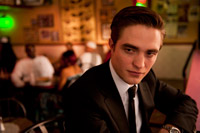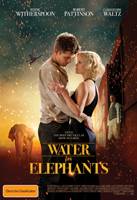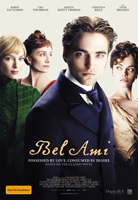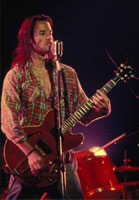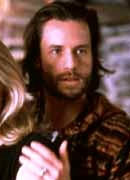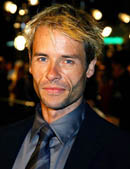Guy Pearce and Robert Pattinson The Rover
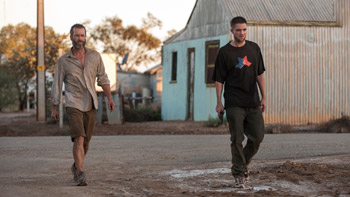
Guy Pearce and Robert Pattinson The Rover
Cast: Guy Pearce, Robert Pattinson
Director: David Michod
Genre: Drama
Rated: MA15+
Running Time: 103 minutes
Synopsis: Ten years after a collapse of the western economic system, Australia's mineral resources have drawn the desperate and dangerous to its shores. With society in decline, the rule of law has disintegrated and life is cheap. Eric is a cold and angry drifter who has left everything and everyone behind. When his car – his last possession – is stolen by a gang of desperate desert hustlers, Eric embarks on a ruthless mission to track them down. Along the way, he is forced into an unlikely relationship with Rey, the naïve and injured younger brother of gang member Henry who has left Rey behind in the bloody aftermath of the gang's most recent robbery.
The Rover
Release Date: June 12th, 2014
Note From The Director, David Michod
'The Rover is set in an unspecified near-future, but is, in essence, a film about today. It's about the rapacious capacity for under-regulated Western economies to destroy themselves and it's about the inevitable shifting balance of global power. It's about the seemingly intractable problems of human greed and environmental destruction and the despair these forces might elicit in struggling people. More than anything, it's about the ways these factors affect the emotional lives of individuals.
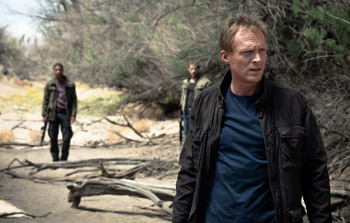 Unlike many films set in a dystopian future, I don't want the devastation of The Rover to be seen as the consequence of a single unforeseen cataclysmic or apocalyptic event. Imagined cataclysms frequently allow viewers or readers an opportunity to distance themselves from the earth and air of the story. I want The Rover to feel like an entirely conceivable world of the very near future, a world despoiled by very real forces and systems at work all around us today.
Unlike many films set in a dystopian future, I don't want the devastation of The Rover to be seen as the consequence of a single unforeseen cataclysmic or apocalyptic event. Imagined cataclysms frequently allow viewers or readers an opportunity to distance themselves from the earth and air of the story. I want The Rover to feel like an entirely conceivable world of the very near future, a world despoiled by very real forces and systems at work all around us today.
The Australian Outback of The Rover is a world ten years after a great Western economic collapse. It's a near future of social and economic decay. Services, utilities, law and order have fallen into dangerous disrepair. And yet people from all corners of the world have come to this place to work the mines that feed the new world alignment, that feed the great powerhouses of this, the Asian century.
The world of the movie, as such, mirrors the American and Australian gold rushes of the 19th century. People are drawn to the land's mines and with them come the leeches, the refuse, the hustlers and criminals who hope to exploit the mines' margins.
This isn't a complete collapse of society - it's an inversion of present-day global power dynamics. This is Australia as a resource-rich Third World country. This is the violence and unrest of contemporary Sierra Leone, DRC, Nigeria and Guinea.
And at the centre of this world are two men - one, a murderously embittered Australian man, a former soldier who has lost his farm and his family; the other, a simple and naive American boy, too young to remember a time when things were anything other than what they are."
Development and Implementation
Written and directed by David Michôd, the writer and directory behind 2011's mesmerising and universally acclaimed Animal Kingdom, The Rover is a ferocious slow burn thriller, in the tradition of an iconic western, with a classic anti-hero at its centre.
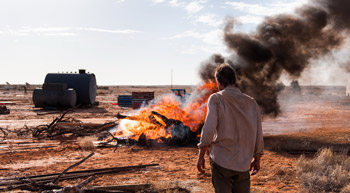 The idea for the film was first conceived in 2007 when friend and actor Joel Edgerton and David Michôd were in Los Angeles, contemplating their next steps. 'We worked for about 10 days nutting out the bare skeleton of a story. Then I went away and started writing the script, and got emotionally involved in it and started feeling like I really wanted to direct it," recalls David Michôd.
The idea for the film was first conceived in 2007 when friend and actor Joel Edgerton and David Michôd were in Los Angeles, contemplating their next steps. 'We worked for about 10 days nutting out the bare skeleton of a story. Then I went away and started writing the script, and got emotionally involved in it and started feeling like I really wanted to direct it," recalls David Michôd. David Michôd left The Rover on ice while he went away and made Animal Kingdom, not knowing what was in store for the sleeper success that culminated in an Academy-Award nomination for Jacki Weaver, amongst countless other awards and acclaim.
Following the excitement of Animal Kingdom's international release, David Michôd decided that his next film would be The Rover and he chose to return to Australia and make the film locally with producer Liz Watts from Porchlight Films, with whom he'd collaborated on Animal Kingdom. When he approached Liz Watts with a first draft script of the film, she was immediately impressed: 'It had a beautiful, simple elegance, which is very much the measure of [David Michôd's] writing, and a complexity behind that simplicity, which made it really intriguing to me."
At that junction producer David Linde also joined the project. David Michôd had met David Linde soon after completing Animal Kingdom. David Linde was quite taken with Animal Kingdom and the two quickly developed a good rapport. David Linde recalls: 'The Rover's combination of narrative elegance and physical intensity seemed a very organic next step for David Linde. I think it was pretty clear to all of us that it was important that he make something he had written and that is how we started talking about doing The Rover together."
David Linde continues: 'I was always confident in how much thought and preparation David Michôd was going to put into making the film… Liz Watts is a fabulous producer and was involved as early as I was, so it was a great confluence of mutual perspective in support of what David Michôd wanted to do. It always felt very complete."
It was the first time David Linde had produced a film in Australia. He had recently set up Lava Bear Films in the USA, and was a very welcomed addition to the production. Says Liz Watts, 'It was a really neat sort of opportunity for us to work with an American producer who has such an amazing level of experience and is creatively strong and at the same time having the freedom to be able to shoot a film in Australia."
Interestingly, before they shot even a frame of film, the filmmakers had secured distribution in about 75 per cent of the world. Roadshow Films acquired rights for Australia and New Zealand while FilmNation acquired the majority of worldwide sales rights, in addition to managing US sales with UTA Independent Film Group. Lava Bear also brought in distribution relationships with certain territories. FilmNation were carefully selected to spearhead the international distribution sales. It was important to the team that Michôd's film was brought to life in the best way possible in each market and FilmNation had proved themselves through their history of working well with directors of real distinction, such as Steven Soderbergh and Pedro Almodóvar.
Shooting in Australia meant the production was able to seek significant investment through the federal agency, Screen Australia, with state bodies South Australian Film Corporation (for 6 shooting in South Australia) and Screen NSW (for post-production in Sydney) also backing the film. Together with the Australian Producers' Offset, the finance of the film was secured.
When it came to casting the film, David Michôd had Guy Pearce in mind for the role of Eric, the titular Rover, from early on. David Michôd had developed the character to be a man in his mid-40s who had lived a life experiencing the gradual but steady economic collapse of the film's world. 'I wanted the character to be a guy who had seen that w
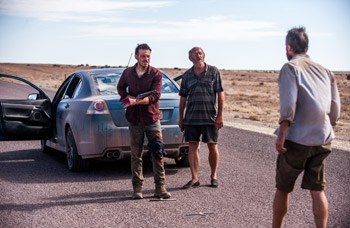 orld collapse, remembered a time when things were different and was carrying around a jaded resentment that was bubbling in a really murderous and dangerous way… When I started thinking about that I really started thinking about Guy Pearce," says David Michôd. 'I effectively wrote the character for Guy Pearce. I always wanted there to be something powerful and detailed, emotional and yet strangely unavailable about the character. I feel like I've spent quite a bit of time with Guy Pearce now and he remains a mystery to me and I think that's a wonderful quality for an actor to have, an unknowability, which made him perfect for the character."
orld collapse, remembered a time when things were different and was carrying around a jaded resentment that was bubbling in a really murderous and dangerous way… When I started thinking about that I really started thinking about Guy Pearce," says David Michôd. 'I effectively wrote the character for Guy Pearce. I always wanted there to be something powerful and detailed, emotional and yet strangely unavailable about the character. I feel like I've spent quite a bit of time with Guy Pearce now and he remains a mystery to me and I think that's a wonderful quality for an actor to have, an unknowability, which made him perfect for the character." Guy Pearce had worked with David Michôd on Animal Kingdom. Although he was a huge fan of Michôd's work and knew that ultimately he would make something interesting and powerful, upon first reading the script for The Rover Guy Pearce admits 'it was difficult, to be honest, at first, to really get my head around it because so much of what occurs in this film is emotional and it's really subversive… The plot is relatively straightforward, but the drama of what is going on for these characters is so internalised, and what's going on for the world at this stage is so under-the-surface that it took me a few reads and a lot of conversations with David Michôd to really understand what it was he was after."
The next step was to build a cast around Guy Pearce that David Michôd felt confident in. The global success of Animal Kingdom opened doors for him in Los Angeles, and he was in the privileged position to be able to audition some heavyweights. Working with Casting Director Kirsty McGregor, and Lava Bear's President of Production Tory Metzger, David Michôd spent a lot of time reviewing the work of various actors, so by the time he auditioned Robert Pattinson he had worked out what he wanted for the character of Rey. David Michôd had never seen a Twilight film and wasn't overly familiar with Robert Pattinson, but upon meeting together in LA, and after his audition Robert Pattinson quickly became his favourite for the role. Recalls David Michôd: 'His performance in the tests was really great and real and moving. What I also liked about him was that it was really quite evident to me from our first conversation that he really wanted to do it."
David Michôd met US actor Scoot McNairy in New Orleans briefly while Scoot McNairy was filming Andrew Dominik's Killing Them Softly and David Michôd was visiting the set. While they initially discussed the role of Rey, and although David Michôd was greatly impressed by his performance, they both agreed he was a little too old for the character. Not surprisingly, when it came time to cast Rey's older brother Henry, Scoot McNairy was the obvious choice.
David Michôd then carefully handpicked the rest of the cast to include David Field, Tawanda Manyimo, Gillian Jones, Anthony Hayes and Susan Prior, ensuring each character was unique, yet had relevance to the new-Australia setting of the film.
About The Production
The Rover was shot over a seven-week period in remote South Australia.
Choosing the Flinders Ranges was the most logical choice for the filmmakers, after checking other areas in the country. David Michôd explains: 'I wanted there to be hills yet some parts that felt busted and urban and other parts that felt entirely desolate while it was still important that some parts were strangely beautiful. It became quite apparent that that sort of variety in a not too daunting geographical sphere could best be found in the Flinders Ranges."
The shoot was a road trip of sorts, north from Adelaide, that wound through the incredible beauty and starkness of the Flinders Ranges, and saw visits to towns along this stretch including Quorn, Bruce, Hammond, Parachilna and Leigh Creek. The longest stay (three weeks) was in Marree, a small town eight hours north of Adelaide, close to Lake Eyre, at the junction of the Oonandatta 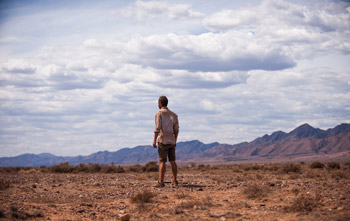 Track and the Birdsville Track. When Liz Watts and David Michôd did early scouts to the area, they always knew that they wanted to shoot in the town. It's a unique outpost at the end of the bitumen before the Simpson Desert, and, before The Rover, no feature film had ever been filmed in this town with a population of only 90 people. A highly regarded documentary, John Heyer's The Back of Beyond (about legendary Outback mailman Tom Cruze), was shot there in the 1950s, but nothing since. The shoot more than doubled the town's population with 100 plus cast and crew descending on Marree for the duration of filming.
Track and the Birdsville Track. When Liz Watts and David Michôd did early scouts to the area, they always knew that they wanted to shoot in the town. It's a unique outpost at the end of the bitumen before the Simpson Desert, and, before The Rover, no feature film had ever been filmed in this town with a population of only 90 people. A highly regarded documentary, John Heyer's The Back of Beyond (about legendary Outback mailman Tom Cruze), was shot there in the 1950s, but nothing since. The shoot more than doubled the town's population with 100 plus cast and crew descending on Marree for the duration of filming.
The remote location was a welcomed retreat for the cast: Publicans Phil and Maz, who manage The Marree Hotel that housed the cast and crew, explain: '(The town folk) are intrigued about the development of the movie, but as far as high profile actors go, they wouldn't really know them if they tripped over them."
Given the isolated location (there was only one phone line and no mobile phone reception), a sense of camaraderie developed between the locals, cast and filmmakers. Robert Pattinson summarises the experience: 'It's really interesting. I've never shot anywhere like this before, there's just nothing for miles and miles and miles. I think it's really fun to work with a crew in a tiny little town where everybody's hanging out with each other all the time. You develop a great bond, and I haven't had that for a while. You don't get that so much with big studio movies."
Production designer Jo Ford: 'In South Australia, you can virtually walk up to anyone's door, bang on it, say, -let me in, I want to see what you've got to offer by way of sets,' and they'll only be too happy. They're country people and really open, and we found people couldn't help us enough. We've made lots of friends and their stories became our back stories for The Rover If I come back to do another film in South Australia, I'll be knocking on those doors again."
The Marree township really embraced the film, as did other towns such as Quorn, and a number of locals were actually cast in some of the smaller roles. Kirsty McGregor also did three casting trips up and down the Flinders looking for locals who joined the production in small roles.
Initially, the main concern for production with shooting in the Flinders Ranges was the weather – specifically the heat and the ability of the cast and crew to work in these conditions. The production was set to shoot in the hottest, driest months for the areas. Liz Watts adds, 'The look of the film was always meant to be hot and we wanted the audience to be feeling that heat and we've really achieved that in these areas of shooting." When first visiting some of the towns to do their recces, the filmmakers faced temperatures of 50 degrees Celsius (122 Fahrenheit), and were convinced that both the cast and crew alike would quit on arrival. It was a serious concern for production and one that was counteracted with immense planning and preparation.
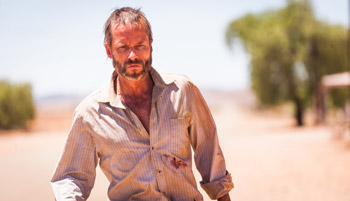 David Michôd worked closely with the set and costume design teams to create the film's colour palette, and to set the reflective back-story of the film. A tremendous amount of organisation and infrastructure had to be put in place for the shoot, and Ford was responsible for bringing the set to life. David Michôd explains: 'In some cases it was just augmenting what was already there, but otherwise Jo Ford had a pretty big and daunting job as production designer. Everywhere we went she would have to truck stuff in, and, to a certain extent, break stuff down as well… There were certain towns and places we went to that needed some serious degeneration work. Jo Ford's great at that."
David Michôd worked closely with the set and costume design teams to create the film's colour palette, and to set the reflective back-story of the film. A tremendous amount of organisation and infrastructure had to be put in place for the shoot, and Ford was responsible for bringing the set to life. David Michôd explains: 'In some cases it was just augmenting what was already there, but otherwise Jo Ford had a pretty big and daunting job as production designer. Everywhere we went she would have to truck stuff in, and, to a certain extent, break stuff down as well… There were certain towns and places we went to that needed some serious degeneration work. Jo Ford's great at that."
David Michôd =had a very clear vision of how he wanted things to look. Jo Ford says, 'It's always a process of downloading the director's brain… When you're designing with David Michôd, even though he says he doesn't know how something should look, he does know – because he wrote it. So he absolutely has a vision of what he wants and developing a shared perspective is central to our work together." For the cinematography, a lot of time was spent working out how to best convey the story and the destruction of the world. Director of Photography Natasha Braier says, ' The challenge was to find the language of the movie, because the movie's very minimalist. There are some action moments, but it's all about the atmosphere and the relationship with these two people and the tension between them, so probably the most challenging was to find what was underneath."
Natasha Braier explains that in order to convey the decline of the world they used camera and design to represent collapse. 'We placed things more at a ground level and sometimes positioned the lights so they came from the ground to convey a sense of collapse; that the infrastructure in this world is breaking down."
The filmmakers chose to shoot on Super 35 film instead of digital, deeming it the most suitable format texturally for this movie. Says Natasha Braier, '(Super 35 film) is the most beautiful format and it's still far better than digital. Also I think shooting in an environment like this, with the intense contrast and heat, film is much more forgiving and versatile than a digital camera. But it was mainly an aesthetic choice."
As it turned out, The Rover would be the last feature film – shot on film – to be processed in Australia. Where only a few years ago there were three labs for processing film in Australia, today there are none.
The shoot moved across a number of regional areas in South Australia, shooting in five key areas: around Port Augusta; Quorn and its neighbours, Hammond and Bruce; Hawker; Parachilna and finally the unique Marree.
Post-production work was done in Sydney, Australia, with a total of 13 weeks editing and 13 weeks sound editing and mixing. Visual effects were completed in Sydney by Fuel VFX.
The Story And It's Primary Characters
The Rover is set in a degraded world, about 10 years after a severe Western economic collapse. In a period David Michôd likens to a Gold Rush or, the more contemporary periods of unrest in Sierra Leone, DRC and Guinea, the mines are one of the only industries still fully operating in Australia principally to feed the still growing economies of China and other Asian centres, and people from all corners of the globe have crawled out to work in and around them.
With harsh economic times comes a desperate struggle for survival, and this world has dragged hustlers and criminals out to the margins of this mining world. In what is almost a de-evolution of humanity, people are forced to do whatever they need to in order to get by. Guy Pearce expands: 'The world has really fallen into mayhem. It's desperate, and I think it's totally possible that our world could go that way… I think The Rover is just a version of how it could have gone wrong or how it could go wrong."
Liz Watts agrees that the desperation of the world of the film is a potentially realistic one: 'The world of the film is really relevant given the economic collapses in 2008, and Australia has survived that crisis in part because of exports to China and the strength of its mining."
David Michôd explains: 'There is a strong sort of Asian flavour in the film but, I wanted it to feel like people have come from everywhere, from all corners of the world." Rey is a southern American who has travelled with his older brother Henry to Australia to work in the mines. Robert Pattinson and Scoot McNairy are the only American accented characters in the film, but a lot of other accents join them, including Mandarin, Cambodian and of course, Australian. Pattinson's character speaks some words of Mandarin, and Manyimo, who plays Caleb, has a New Zealand/Zimbabwe accent in real life which Michôd chose to keep this in the film. It was important for the world of the film that accents play across nationalities.
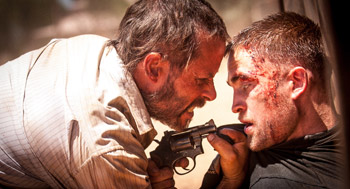 Both Liz Watts and David Linde also describe the film as having elements of a Western, largely due to the landscape and character dynamics. David Linde says, 'It feels to me very much in a tradition of filmmaking evoked by the great Westerns, a violent world where men struggle with real moral questions as they confront their very survival".
Both Liz Watts and David Linde also describe the film as having elements of a Western, largely due to the landscape and character dynamics. David Linde says, 'It feels to me very much in a tradition of filmmaking evoked by the great Westerns, a violent world where men struggle with real moral questions as they confront their very survival". The story is a seemingly simple one; it follows the physical journey of the two main characters, Eric (Guy Pearce) and Rey (Robert Pattinson), as they embark on a road trip to find Rey's older brother Henry (Scoot McNairy). But the subtle plot gives reign to the emotional development of the characters, and this can be seen predominantly through the union of Eric and Rey. Their journey together becomes an intensely emotional one, as the unlikely acquaintances are forced to deal with their own inner turmoil. The film's setting is full of people forming some kind of pairing in order to survive and Eric and Rey will join them.
When we first meet Eric at the start of the film, he has basically reached the end of the line. As the world around him has disintegrated, Eric too has disintegrated. Guy Pearce explains: 'We find him at an extreme low point… He has nothing left in his life… The lack of justice in this world has eaten away at him."
Eric is, from the beginning, on an individual journey of sorts. His car is his one last possession and it carries a deep personal significance for him, so when it is stolen by a trio of petty criminals, he sets out on a ruthless mission to get it back – whatever the consequences. Eric has lost all hope and does not care about anything or anyone in this world. His hunt for his car is as much about his need for some kind – any kind – of momentum as it is about his attachment to the car itself.
At the point the two meet, Rey's journey is about survival. In the bloody aftermath of a heist gone wrong, Rey has been abandoned by his older brother, Henry, and friends, Archie and Caleb, who have left him to die on the side of the road. Upon finding Rey, Eric makes it his mission to seek the medical help Rey needs to survive so he can lead him to Henry and his vehicle. And so their journey together along a dusty and dangerous road begins.
Guy Pearce explains: 'We certainly see initially how vulnerable Rey is in the world, particularly as he's injured and he's been left behind by his brother. Eric really has no interest… he has not one iota of compassion for this kid. He purely is using him to get back what he needs." So the two men are forced to stick together out of necessity.
Robert Pattinson describes Rey as 'a dependant who has been protected by people his entire life, but he has also burdened them, and he thinks that he can't really live as an independent person. He's a little slow, and very, very needy, and he feels like he needs people to look after him all the time." Throughout the film, there are several developments that progress Eric and Rey's emotional journey. Guy Pearce says, 'Eric finds some sparks of life and love, ultimately through Rey, that don't necessarily wake him up and change him or give him any sense of hope or positivity, but they kind of confuse him because he's lived for so long now in a very depressed state… We see the power shift a little bit, and we actually see that Eric starts to feel something for this kid, and that is not good for Eric. He hasn't felt anything for anybody for 10 years or so, so it becomes a really complex scenario for him."
The Rover
Release Date: June 12th, 2014
Have You Seen This?
MORE
- Mission: Impossible Fallout
- Glenn Close The Wife
- Allison Chhorn Stanley's Mouth Interview
- Benicio Del Toro Sicario: Day of the Soldado
- Dame Judi Dench Tea With The Dames
- Sandra Bullock Ocean's 8
- Chris Pratt Jurassic World: Fallen Kingdom
- Claudia Sangiorgi Dalimore and Michelle Grace...
- Rachel McAdams Disobedience Interview
- Sebastián Lelio and Alessandro Nivola...
- Perri Cummings Trench Interview

